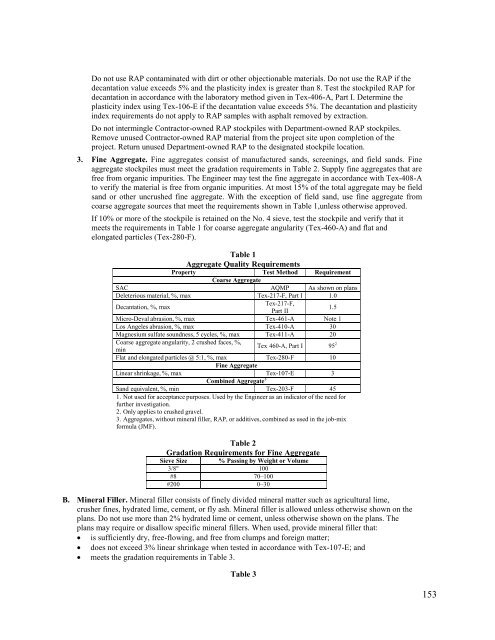Summary of Rubber Modified Asphalt Product Specifications around ...
Summary of Rubber Modified Asphalt Product Specifications around ...
Summary of Rubber Modified Asphalt Product Specifications around ...
You also want an ePaper? Increase the reach of your titles
YUMPU automatically turns print PDFs into web optimized ePapers that Google loves.
Do not use RAP contaminated with dirt or other objectionable materials. Do not use the RAP if the<br />
decantation value exceeds 5% and the plasticity index is greater than 8. Test the stockpiled RAP for<br />
decantation in accordance with the laboratory method given in Tex-406-A, Part I. Determine the<br />
plasticity index using Tex-106-E if the decantation value exceeds 5%. The decantation and plasticity<br />
index requirements do not apply to RAP samples with asphalt removed by extraction.<br />
Do not intermingle Contractor-owned RAP stockpiles with Department-owned RAP stockpiles.<br />
Remove unused Contractor-owned RAP material from the project site upon completion <strong>of</strong> the<br />
project. Return unused Department-owned RAP to the designated stockpile location.<br />
3. Fine Aggregate. Fine aggregates consist <strong>of</strong> manufactured sands, screenings, and field sands. Fine<br />
aggregate stockpiles must meet the gradation requirements in Table 2. Supply fine aggregates that are<br />
free from organic impurities. The Engineer may test the fine aggregate in accordance with Tex-408-A<br />
to verify the material is free from organic impurities. At most 15% <strong>of</strong> the total aggregate may be field<br />
sand or other uncrushed fine aggregate. With the exception <strong>of</strong> field sand, use fine aggregate from<br />
coarse aggregate sources that meet the requirements shown in Table 1,unless otherwise approved.<br />
If 10% or more <strong>of</strong> the stockpile is retained on the No. 4 sieve, test the stockpile and verify that it<br />
meets the requirements in Table 1 for coarse aggregate angularity (Tex-460-A) and flat and<br />
elongated particles (Tex-280-F).<br />
Table 1<br />
Aggregate Quality Requirements<br />
Property Test Method<br />
Coarse Aggregate<br />
SAC AQMP<br />
Deleterious material, %, max Tex-217-F, Part I<br />
Requirement<br />
As shown on plans<br />
1.0<br />
Decantation, %, max<br />
Tex-217-F,<br />
1.5<br />
Part II<br />
Micro-Deval abrasion, %, max Tex-461-A Note 1<br />
Los Angeles abrasion, %, max Tex-410-A 30<br />
Magnesium sulfate soundness, 5 cycles, %, max Tex-411-A 20<br />
Coarse aggregate angularity, 2 crushed faces, %,<br />
min Tex 460-A, Part I 95 2<br />
Flat and elongated particles @ 5:1, %, max Tex-280-F 10<br />
Fine Aggregate<br />
Linear shrinkage, %, max Tex-107-E 3<br />
Combined Aggregate 3<br />
Sand equivalent, %, min Tex-203-F 45<br />
1. Not used for acceptance purposes. Used by the Engineer as an indicator <strong>of</strong> the need for<br />
further investigation.<br />
2. Only applies to crushed gravel.<br />
3. Aggregates, without mineral filler, RAP, or additives, combined as used in the job-mix<br />
formula (JMF).<br />
Table 2<br />
Gradation Requirements for Fine Aggregate<br />
Sieve Size % Passing by Weight or Volume<br />
3/8" 100<br />
#8 70–100<br />
#200 0–30<br />
B. Mineral Filler. Mineral filler consists <strong>of</strong> finely divided mineral matter such as agricultural lime,<br />
crusher fines, hydrated lime, cement, or fly ash. Mineral filler is allowed unless otherwise shown on the<br />
plans. Do not use more than 2% hydrated lime or cement, unless otherwise shown on the plans. The<br />
plans may require or disallow specific mineral fillers. When used, provide mineral filler that:<br />
is sufficiently dry, free-flowing, and free from clumps and foreign matter;<br />
does not exceed 3% linear shrinkage when tested in accordance with Tex-107-E; and<br />
meets the gradation requirements in Table 3.<br />
Table 3<br />
153


